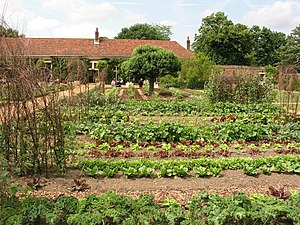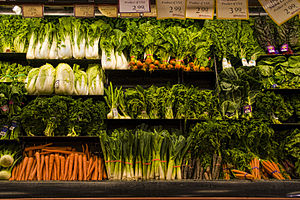Vegetable: Edible plant or part of a plant, involved in cooking
Vegetables are parts of plants that are eaten by humans as food as part of a meal.
This meaning is often used: it is applied to plants to mean all edible plant matter, including the flowers, fruits, stems, leaves, roots, and seeds.


Carrots and potatoes are parts of the root of the plants, but since they are eaten by humans, they are vegetables. They are not in the same category as a fruit, nut, herb, spice, or grain. Tomatoes are often thought of as vegetables, but because they have seeds, they are, botanically, fruits. Vegetables are an important part of people's diet. Vegetables and fruits are sometimes called produce. Vegetables have vitamins A, B, C, D, minerals and carbohydrates.
The USDA Dietary Guidelines for Americans recommends eating five to nine servings of fruit and vegetables everyday. The total amount eaten varies depending on age and gender.
Etymology

The word vegetable was first recorded in English in the early 15th century. It comes from Old French. It is gotten from Medieval Latin vegetabilis "growing, flourishing" (i.e. of a plant).
The meaning of "vegetable" as a "plant grown for food" was not accepted until the 18th century. The year 1955 saw the first use of the slang term "veggie".
Terminology
The word "vegetable" can also be used to mean plants in general, such as when people say "Animal, Vegetable, or Mineral."
However, in an Asian context, 'vegetable' may mean any plant produce, apart from grain and nuts, that is eaten cooked, while only the fruits eaten raw are considered as 'fruits'. For example, an artichoke is thought to be a vegetable, while a melon has the features of a fruit.
"Fruit" has a botanical meaning. Peaches, plums, and oranges are known as "fruits". Many plants commonly called "vegetables", such as eggplants, bell peppers, and tomatoes, are fruits in botany. The question of is a tomato a fruit or a vegetable was asked in the United States Supreme Court in 1893. The court ruled that a tomato is, and thus taxed as, a vegetable. This was for the Tariff of 1883 on imported produce. But the court knew that a tomato is a fruit in botany.
History
Before agriculture, humans were hunter-gatherers. They looked for fruit, nuts, stems, leaves, corms, and tubers, scavenged for dead animals and hunted living ones for food. Growing crops in a forest clearing is thought to be the first example of agriculture. Useful types of plant were grown while unwanted plants were removed. Plant breeding through the selection of plant with wanted characteristics such as large fruit and fast growth soon started.
It is likely that many people around the world started growing crops in the period 10,000 BC to 7,000 BC. Subsistence agriculture was the earliest form of agriculture. It involves the growing of crops by people to produce enough food for their families. Anything left is used for exchange for other goods.
Throughout history, the rich have been able to afford different kinds of food including meat, vegetables and fruit. But for poor people, the food they ate was very dull. It is usually made up of mainly some staple product made from rice, rye, barley, wheat, millet or maize. The addition of vegetable gave some variety to the diet.
Common vegetables
| Some common vegetables | |||||
|---|---|---|---|---|---|
| Image | Species | Parts of the plant used | Where it came from | Cultivars | World production (×106 tons, 2018) |
 | Brassica oleracea | leaves, axillary buds, stems, flower heads | Europe | cabbage, brussels sprouts, cauliflower, broccoli, kale, kohlrabi, red cabbage, Savoy cabbage, Chinese broccoli, collard greens | 69.4 |
 | Brassica rapa | root, leaves | Asia | turnip, Chinese cabbage, napa cabbage, bok choy | |
 | Raphanus sativus | root, leaves, seed pods, seed oil, sprouting | Southeastern Asia | radish, daikon, seedpod varieties | |
 | Daucus carota | root, leaves, stems | Persia | carrot | 40.0 |
 | Pastinaca sativa | root | Eurasia | parsnip | |
 | Beta vulgaris | root, leaves | Europe and Near East | beetroot, sea beet, Swiss chard, sugar beet | |
 | Lactuca sativa | leaves, stems, seed oil | Egypt | lettuce, celtuce | 27.2 |
 | Phaseolus vulgaris, Phaseolus coccineus, Phaseolus lunatus | pods, seeds | Central and South America | green bean, French bean, runner bean, haricot bean, Lima bean | 55.1 |
 | Vicia faba | pods, seeds | Mediterranean and Middle East | broad bean | 4.9 |
 | Pisum sativum | pods, seeds, sprouts | Mediterranean and Middle East | pea, snap pea, snow pea, split pea | 34.7 |
| Solanum tuberosum | tubers | South America | potato | 368.1 | |
| Solanum melongena | fruits | South and East Asia | eggplant (aubergine) | 54.0 | |
| Solanum lycopersicum | fruits | South America | tomato | 182.2 | |
| Cucumis sativus | fruits | Southern Asia | cucumber | 75.2 | |
| Cucurbita spp. | fruits, flowers | Mesoamerica | pumpkin, squash, marrow, zucchini (courgette), gourd | 27.6 | |
| Allium cepa | bulbs, leaves | Asia | onion, spring onion, scallion, shallot | 102.2 | |
| Allium sativum | bulbs | Asia | garlic | 28.5 | |
| Allium ampeloprasum | leaf sheaths | Europe and Middle East | leek, elephant garlic | 2.2 | |
| Capsicum annuum | fruits | North and South America | pepper, bell pepper, sweet pepper | 40.9 | |
| Spinacia oleracea | leaves | Central and southwestern Asia | spinach | 26.3 | |
| Dioscorea spp. | tubers | Tropical Africa | yam | 72.6 | |
| Ipomoea batatas | tubers, leaves, shoots | Central and South America | sweet potato | 91.9 | |
| Manihot esculenta | tubers | South America | cassava | 277.8 | |
Nutrition and health

Vegetables are very important in human nutrition. Most vegetables are low in calories but are large and filling. They are a source of dietary fiber, essential vitamins, minerals, and trace elements.
When people eat more vegetables, it reduces the incidence of cancer, stroke, cardiovascular disease, and other chronic ailments. The amount of nutrients of each vegetable is different. Some have useful amounts of protein though and varying proportions of vitamins such as vitamin A, vitamin K, and vitamin B6, provitamins, minerals; and carbohydrates.
Vegetables are commonly eaten raw. It may become contaminated when they are made by an infected food handler. Hygiene is important when handling foods to be eaten raw. These vegetables need to be properly cleaned, handled, and stored to stop contamination.
Production
Cultivation

Vegetables have been big part of what humans eat. Some vegetables are perennial crops but most are annual and biennial crops. Cultivation of vegetables follows a particular pattern. The pattern is usually followed like this:
- Preparation of the soil by loosening it
- Removing or burying weeds
- Adding organic manures or fertilizers
- Sowing seeds or planting young plants
- Taking care of the crop while it grows to reduce the weeds, control pests, and provide enough water
- Harvesting the crop when it is ready
- Sorting, storing, and marketing the crop or eating it fresh from the ground
On a small garden, tools like the spade, fork, and hoe are used. On commercial farms, mechanical equipments are used. These include tractors, ploughs, harrows, transplanters, cultivators, irrigation equipment, and harvesters.
Harvesting

When a vegetable has matured it is ready to be harvested for storage or sale. There should be little damage and bruising to the crop when harvesting. Before storage or sale, damaged goods should be removed and produce should be picked according to its quality, size, ripeness, and color.
Storage
All vegetables have to be stored to make them available all year round. A large proportion of vegetables are lost after harvest during the storage period. The main causes of loss include spoilage caused by moisture, moulds, micro-organisms, and pests.
Storage can be short-term or long-term. During storage, leafy vegetables lose moisture, and the vitamin C in them is lost quickly.
Cold storage is useful for vegetables like cauliflower, eggplant, lettuce, radish, spinach, potatoes, and tomatoes. Storage of fruit and vegetables in controlled atmospheres with high levels of carbon dioxide or high oxygen levels can stop microorganisms from growing.
Preservation
The reason why vegetables are preserved is to make them available all year round. The goal is to harvest the food when it is mature with a high nutritional value, and preserve these qualities for a longer period of time. The main causes of spoilage during storage are the actions of naturally-occurring enzymes and micro-organisms. There are many ways to preserve vegetables and they are:
- Canning: First, the enzymes and the micro-organisms in vegetables are destroyed by heat. The sealed can prevents air from going to the food to prevent the decomposition of food. The lowest necessary heat and the minimum processing time are used in order to prevent the breakdown of the product. It is also done to preserve the flavor for a long time. One can now store the can at room temperature for a long time.
- Freezing vegetables to below −10 °C (14 °F) will stop them from spoiling for a short period of time. But freezing vegetables to below −18 °C (0 °F) will stop them from spoiling for a longer period of time. Not all micro-organisms will be killed at these temperatures so after thawing the vegetables should be used be used immediately because any microbes there will start to grow.
- Traditionally, sun drying has been used for hundreds of years. Some vegetables such as tomatoes, mushrooms, and beans, can be sun dried by spreading the vegetables on racks under the Sun. But modern sun drying uses solar powered driers.
- Fermentation is another method of preserving vegetables for later use. Sauerkraut is made from chopped cabbage and depends on lactic acid bacteria which make compounds that stops other micro-organisms from growing.
- High levels of both sugar and salt can preserve food by stopping micro-organisms from growing. Green beans can be salted by covering the beans with salt. But this method of preservation is not used for other vegetables. Marrows, beetroot, carrot, and some other vegetables can be boiled with sugar to create jams.
Top producers

In 2010, China was the largest vegetable producing nation, with over half the world's production. India, the United States, Turkey, Iran, and Egypt were the next largest producers. Here is a table with the needed information.
| Country | Area cultivated thousand hectares (2,500 acres) | Yield thousand kg/ha (890 lb/acre) | Production thousand tonnes (1,100 short tons) |
|---|---|---|---|
| China | 23,458 | 230 | 539,993 |
| India | 7,256 | 138 | 100,045 |
| United States | 1,120 | 318 | 35,609 |
| Turkey | 1,090 | 238 | 25,901 |
| Iran | 767 | 261 | 19,995 |
| Egypt | 755 | 251 | 19,487 |
| Italy | 537 | 265 | 14,201 |
| Russia | 759 | 175 | 13,283 |
| Spain | 348 | 364 | 12,679 |
| Mexico | 681 | 184 | 12,515 |
| Nigeria | 1844 | 64 | 11,830 |
| Brazil | 500 | 225 | 11,233 |
| Japan | 407 | 264 | 10,746 |
| Indonesia | 1082 | 90 | 9,780 |
| South Korea | 268 | 364 | 9,757 |
| Vietnam | 818 | 110 | 8,976 |
| Ukraine | 551 | 162 | 8,911 |
| Uzbekistan | 220 | 342 | 7,529 |
| Philippines | 718 | 88 | 6,299 |
| France | 245 | 227 | 5,572 |
| Total world | 55,598 | 188 | 1,044,380 |
References
This article uses material from the Wikipedia Simple English article Vegetable, which is released under the Creative Commons Attribution-ShareAlike 3.0 license ("CC BY-SA 3.0"); additional terms may apply (view authors). Content is available under CC BY-SA 4.0 unless otherwise noted. Images, videos and audio are available under their respective licenses.
®Wikipedia is a registered trademark of the Wiki Foundation, Inc. Wiki Simple English (DUHOCTRUNGQUOC.VN) is an independent company and has no affiliation with Wiki Foundation.